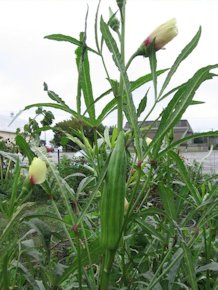
|
Canning Pickled Okra
Okra - Love it or Hate It?
Most people we know either love okra or hate it. As okra season is in full
effect, we offer a little info on the okra to help the haters to give
it a second chance. The okra, a relative to the hibiscus and cotton plant, is a
little tubular vegetable with fuzzy, tender casing and round, edible white
seeds. Okra also has a sticky core that causes the up-turned noses and looks of
disgust among the haters. Some people call it slime, but we like to think of it
as the Glue of Goodness. Besides, the slime helps thicken soups and stews and
adds great flavor. Okra is popular among Southern, Creole, Indian, and African
cuisine. Besides the added taste value, okra is also "gasp" nutritious! It's
a great source of fiber, vitamin C, vitamin B6 and folic acid.
|
| Okra Plant |